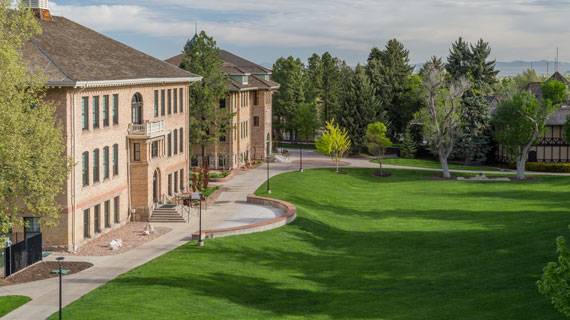SUU Farm Participates in Cooperative Research Project
Published: November 16, 2021 | Author: Abbie Cochrane | Read Time: 4 minutes
 The Southern Utah University Farm recently partnered with Utah State University to study the efficiency of water delivery systems, with the overall goal of helping Utah farmers better utilize water while still producing normal crop yields.
The Southern Utah University Farm recently partnered with Utah State University to study the efficiency of water delivery systems, with the overall goal of helping Utah farmers better utilize water while still producing normal crop yields.
“Most farmers are looking for ways to increase the efficiency of raising crops and livestock, including using water as efficiently as possible,” said Lee Wood, department chair and associate professor of agriculture at SUU. “We all want to be good stewards. The SUU Department of Agriculture and Nutrition faculty and staff are happy and excited to participate in this study, which could be a great benefit to agricultural producers and local communities. We are also excited to provide our agriculture students with the opportunity to observe and participate in a cutting-edge research project like this.”
The experiment was designed by USU Assistant Professor of Agriculture Matt Yost, in consultation with SUU faculty and staff. The goal was to determine how much water was actually necessary to grow certain crops. USU Graduate students spoke to over 50 Southern Utah farmers, as well as Utah Governor Spencer J. Cox about different water delivery systems and their efficiency as well as the output of water they produce. They emphasized that their main goal is to help Utah farmers use less water and still get normal crop yields through a new irrigation system, as well as testing the efficiency of genetically modified drought-tolerant crops, cutting back on the tilling to keep moisture in the soil, and other agricultural management practices.
For the project, USU provided 76 acres of the SUU farm with a new lateral irrigation system. New bubbler and drip line attachments currently sweeping the science of irrigation systems have so far done very well, according to Dr. Yost. Of course, recent monsoonal rains have thrown a loop into Yost and his teams’ research.
Trials were performed on alfalfa, teff grass, sudan grass, and five varieties of corn. The new system is sorted into four levels of water application in order to increase precision. Low Elevation Precision Application (LEPA) is when the sprinkler heads are barely above the crops, therefore reducing between 15-30% of water consumption. Low Elevation Nelson Application (LENA) is relatively similar to LEPA. The Low Elevation Sprinkler Application (LESA) is an adjustment to regular sprinklers that helps to reduce levels of evaporation and wind drift because the nozzle is again placed close to the crops. Finally, Mid Elevation Sprinkler Application (MESA) is the same thing as LESA, just with a higher placement of the sprinkler head.
Yost believes that if these new systems are implemented, farmers can cut back about 20 percent on irrigation rates and still maintain crop production. Despite the fact that the new technology is more expensive, data is showing that it can yield positive long-term benefits.
New Steamer Software was also tested on SUU Farm bales of oat crop as well as bales of alfalfa. The steaming technology proved effective in helping to hydrate the dry plants.
As for the new genetically modified crops, there has been less promise to that approach. The study focused on a corn hybrid that is supposed to be good at handling periods of time with little to no moisture, however, the hybrid is literally and figuratively bearing no fruit. Many drought-tolerant hybrid plants are injected with a gene called bacillus subtilis, which enhances a plant’s ability to tolerate little to no water for longer periods of time by inducing stress-response genes, phytohormones, and stress-related metabolites.
To implement a brand new, expensive irrigation system is a tall order for many, especially after the most recent drought has left many Utah farmers in a tough position financially. This past year has seen water cuts of up to 70-75% during the drought, which has dramatically reduced crop production. Governor Cox concurs that purchasing new equipment is a difficult thing that Southern Utah farmers, as well as farmers across the state, must come to terms with.
“They’re willing to do it,” said Governor Cox. “We just need to make sure that we have the financial assistance to help them make that possible.” Governor Cox also acknowledged the efforts of Iron County farmers to recharge aquifers.
USU and SUU will continue to partner on this project being held at SUU Farm, and will hopefully continue to accumulate promising findings about how to better cut back on water whilst still maintaining the crop yield needed.
Students in SUU’s agricultural sciences and industries program study the latest science behind farming and apply that education first hand on the university’s 800-acre farm and 2,800-acre mountain property. The reputation, internship opportunities, and hands-on nature of the program, combine to earn graduates an excellent track record for job placement in the agriculture field. Learn more about the Department of Agriculture and Nutrition Science at SUU.
Tags: College of Health Sciences Farm Agriculture
Contact Information:
435-586-5400
Contact the Office of Marketing Communication
This article was published more than 3 years ago and might contain outdated information or broken links. As a result, its accuracy cannot be guaranteed.

